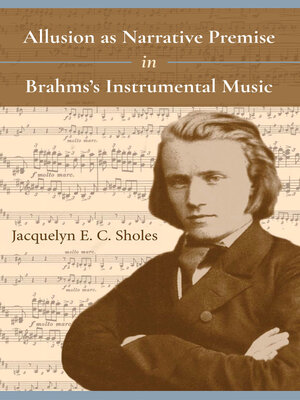
Sign up to save your library
With an OverDrive account, you can save your favorite libraries for at-a-glance information about availability. Find out more about OverDrive accounts.
Find this title in Libby, the library reading app by OverDrive.



Search for a digital library with this title
Title found at these libraries:
| Library Name | Distance |
|---|---|
| Loading... |
A musicologist offers a fresh look at how Brahms used the inspiration of earlier composers in his own instrumental works.
As Jacquelyn E. C. Sholes reveals in this study, an essential aspect of Johannes Brahms's art was the canny use of musical references to the works of others. By analyzing newly identified allusions alongside previously known musical references in works such as the B-Major Piano Trio, the D-Major Serenade, the First Piano Concerto, and the Fourth Symphony, Sholes demonstrates how a historical reference in one movement can resonate meaningfully, musically, and dramatically with material in other movements in ways not previously recognized.
Brahms masterfully wove such references into broad, movement-spanning narratives. Sholes argues that these narratives served as expressive outlets for his complicated attitudes toward the material to which he alludes. Ultimately, Brahms's music reveals both the inspiration and the burden that established masters such as Domenico Scarlatti, J. S. Bach, Haydn, Mozart, Schubert, Schumann, Wagner, and especially Beethoven represented for him as he struggled to establish his own artistic voice and place in musical history.
As Jacquelyn E. C. Sholes reveals in this study, an essential aspect of Johannes Brahms's art was the canny use of musical references to the works of others. By analyzing newly identified allusions alongside previously known musical references in works such as the B-Major Piano Trio, the D-Major Serenade, the First Piano Concerto, and the Fourth Symphony, Sholes demonstrates how a historical reference in one movement can resonate meaningfully, musically, and dramatically with material in other movements in ways not previously recognized.
Brahms masterfully wove such references into broad, movement-spanning narratives. Sholes argues that these narratives served as expressive outlets for his complicated attitudes toward the material to which he alludes. Ultimately, Brahms's music reveals both the inspiration and the burden that established masters such as Domenico Scarlatti, J. S. Bach, Haydn, Mozart, Schubert, Schumann, Wagner, and especially Beethoven represented for him as he struggled to establish his own artistic voice and place in musical history.







